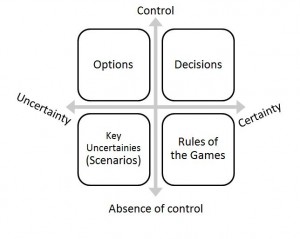In sales, I like to break things down to the simplest component. Selling is tough enough without making complicated with all these forms, scripts and procedures. Most of the things I try to develop are attempts to make qualitative judgments within a sales call or a dialogue. The best skill of course you can have is being a fantastic doodler. It is amazing some of the constructs you can make. Of course, if you are a good artist it certainly helps but you may be too much of a perfectionist to get meaning from the conversation. Between doodling and painting, you have sketching which seems to be all in vogue now and rightfully so.
However, though I certainly qualify as a doodler, I am not much at sketching. I prefer my mind maps to be pretty plain-jane, and more often done on a computer. What I have done through the years is developed many templates that allow me to sort of fill in the blanks during a conversation. I even use to make my only sales book out for a sales call that would have a few of my templates that I thought I would use. If also contained a few questions to prompt me in what I need to ask.
One of those templates, Bain’s RAPIDTM framework (RAPID is an acronym to explain the roles people play in a given situation) I have discussed in the blog post, Value Model Mapping. I also am a big fan of Alex Lowy’s work with 2 x 2 matrixes, an example in the blog post, What Type of Thinking Solves Dilemmas. So like any good SCAMPER advocate I looked at the way to combine both of these ideas into a way that would assist me in the sales process.
Combing through my book shelf as I was working on some thoughts about scenarios, I ran across an old favorite book, Mind of a fox, The: Scenario Planning in Action. In the book, the authors had created a matrix for scenario thinking but first introduced in the way of people. This reminded me a great deal of Bain’s RAPID framework where I could sort of slot people in the conversation on where they may fit. What you find when you do that people seldom stray from their positions. The matrix is below:
Further defining these roles:
- Fence-sitters: Certain sense of control but are hesitant in their decisions
- Control Freaks: Know what will happen because thinking they control the outcome
- Dice–Rollers: Believe everything happens by chance
- Fatalists: Know what’s going to happen but cannot do anything about it.
This forms the basis for the authors’ next statement:
The most important aspect of the newly constituted matrix follows Sherlock Holmes’s line of thinking: first eliminate the impossible before concentrating on the possible. To put it slightly differently, if you want to be truly in charge of your destiny, you first require to know your limitations and be humbler than you think. Hence, the lower layer of the matrix which many people ignore lays a solid foundation for effective thinking in the upper part.
I think that is such a brilliant statement. We must understand what we have little control of and be able to break the two apart in to things we know for certain and the things we do not. With always the caveat of Mark Twains saying, “It ain’t what you don’t know that gets you into trouble. It’s what you know for sure that just ain’t so.
The authors then go into their “Foxy Matrix” and explain it this way:
The first quadrant now represents the rules of the game things that are certain and over which we have no control. The second quadrant has two components: key uncertainties over which we also have no control; and plausible and relevant scenarios derived from these uncertainties, though the scenarios must be vivid and different enough to take us out of the comfort zone. The third quadrant is now identified with the options presented by the scenarios. The formulation of options is crucial and allows us to operate with more control in an uncertain environment. The fourth quadrant is the area where decisions are made based on the preferred scenario and linked to the preferred option. It is also the quadrant where strategic plans and programmes of action should be located, as these are really decision paths formulated in advance. The term “scenario planning” normally denotes the processes one goes through in the first two quadrants. “Rules of the game” are sometimes called “predetermined elements” and “key uncertainties” are “driving forces”. Otherwise, nothing is different in terms of the methodology.
What I enjoy about this matrix is that I can have it drawn on a pad of paper and take the thoughts during a sales conversation and slot the ideas that need to be addressed in this manner. I can take those items that people are certain about and those items that are not. I can also overlay this matrix on top of the first matrix of the people in the room and see who relates to what subject the most. It is sort of a fun exercise but the power of it is not in the categorization of people ideas. Rather, it is a tool for dialogue building.
You would not ask a control freak to discuss something that is certain and they have control. Instead ask a Control Freak about a Scenario or a Dice Roller about a Decision. Crossing the blocks and gaining insights from the opposite direction can lead the conversation into a great learning experience. Opposites attract don’t they? They certainly do when seeking an opinion, try it.





![[Research Round-Up] New Study Shows the Continuing Value of B2B Thought Leadership](https://customerthink.com/wp-content/uploads/development-2010010_1280-pixabay-innovation-ideas-think-1-218x150.jpg)